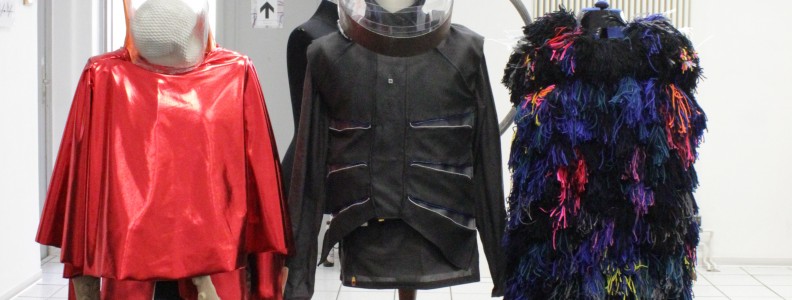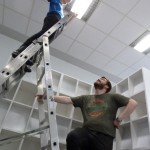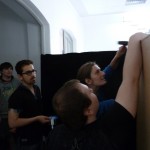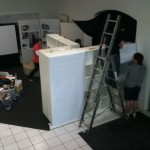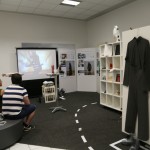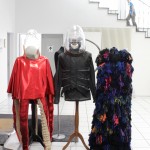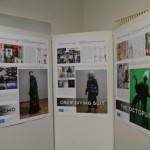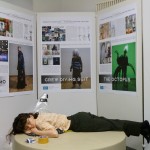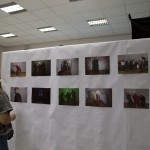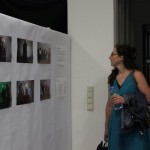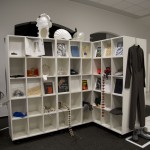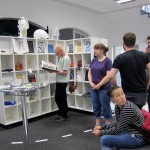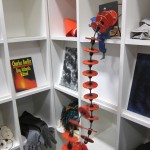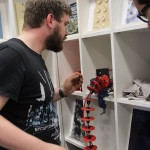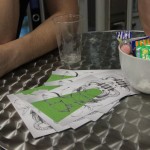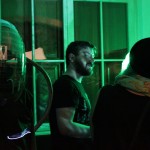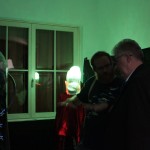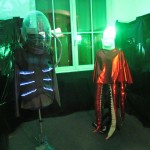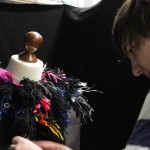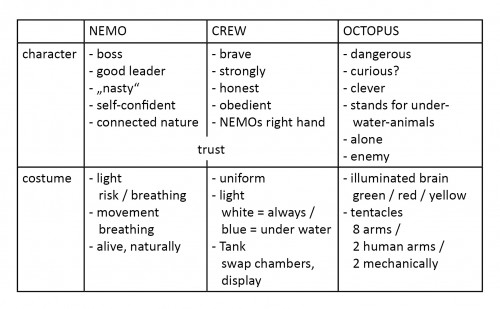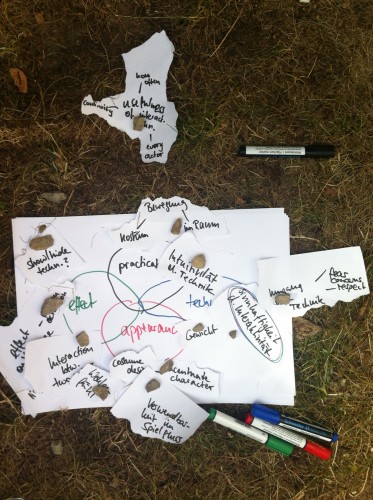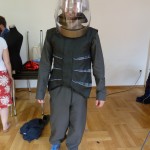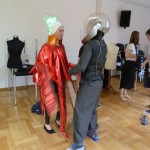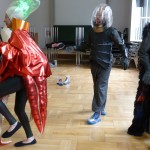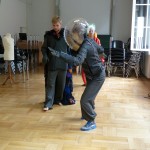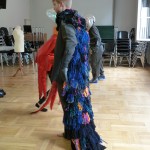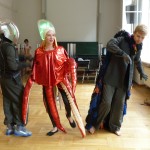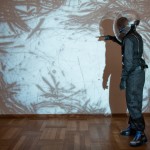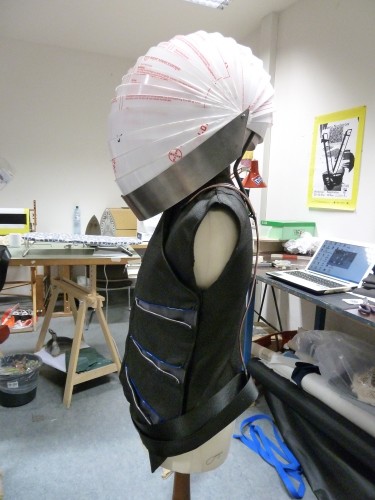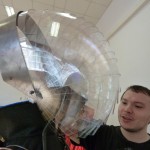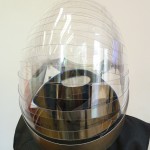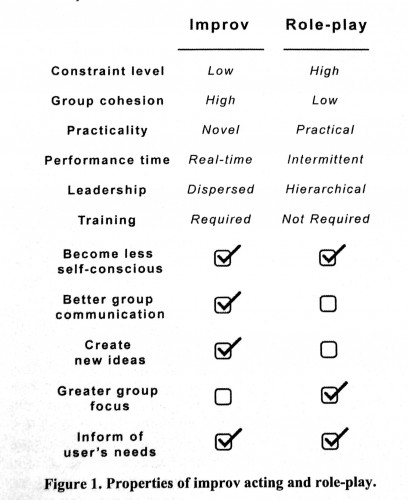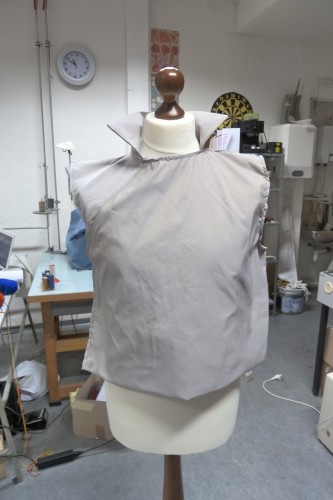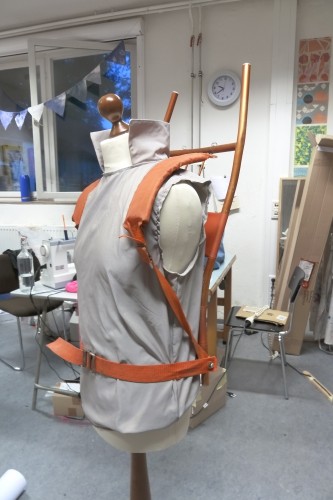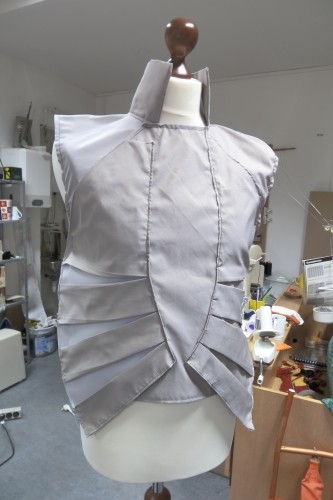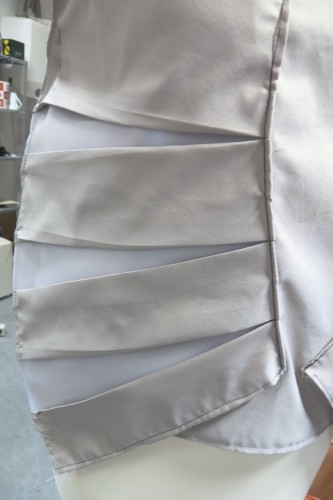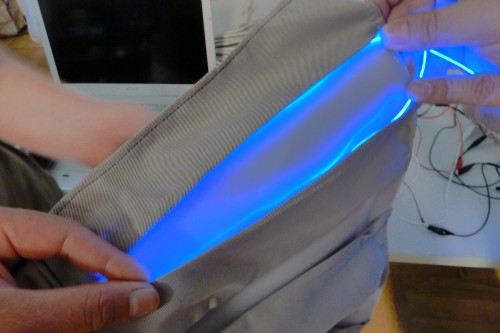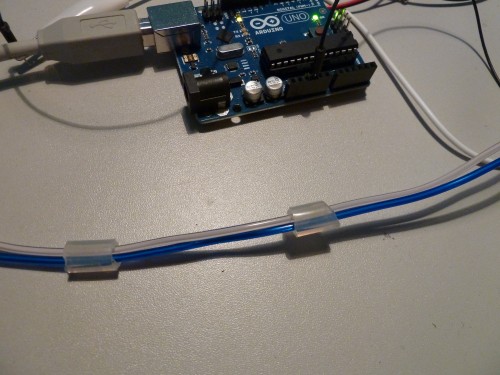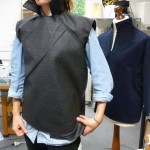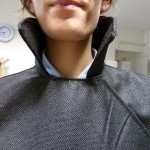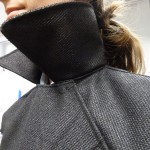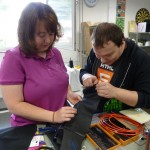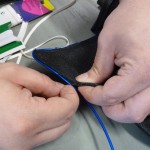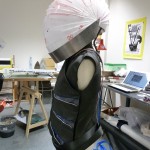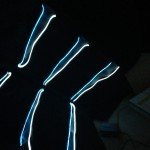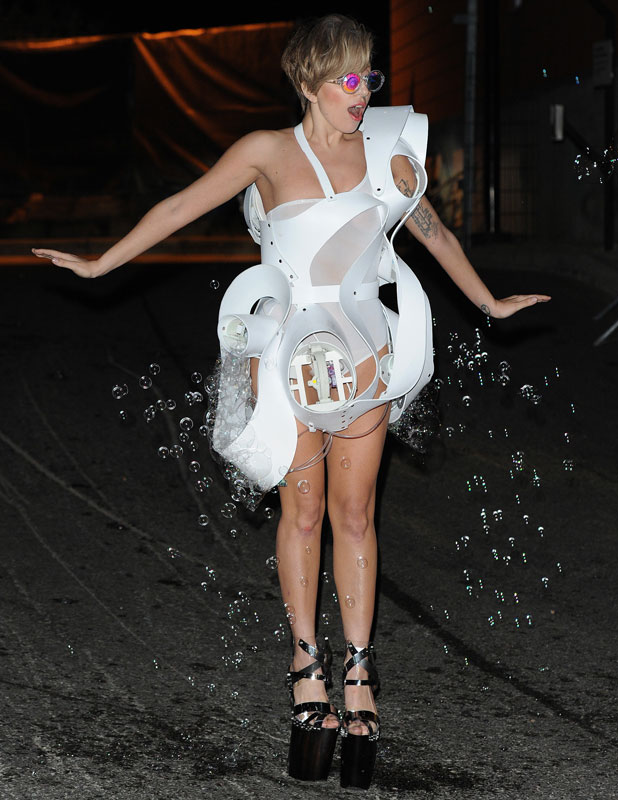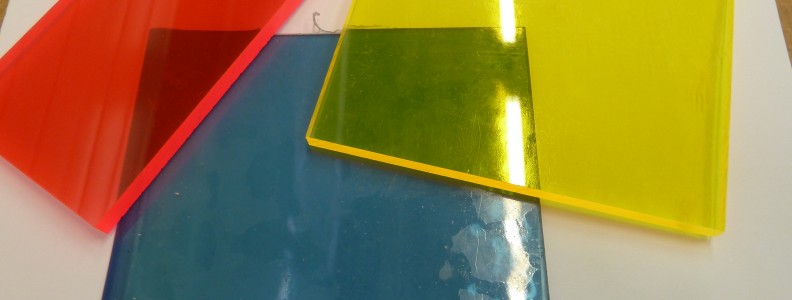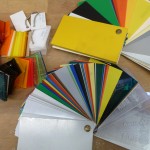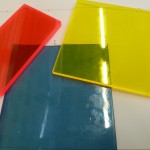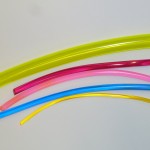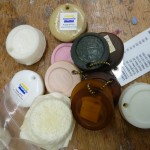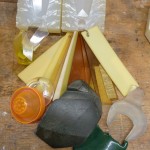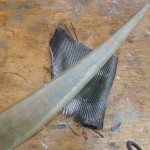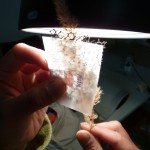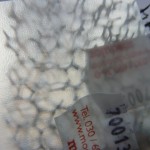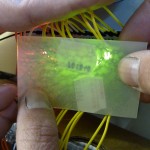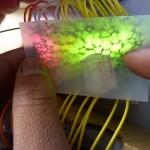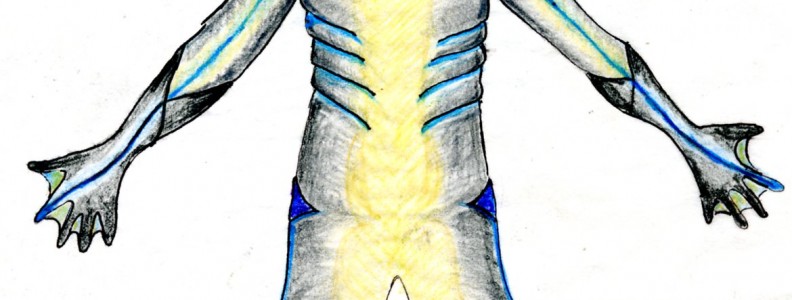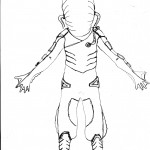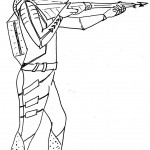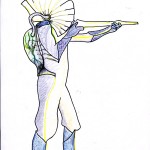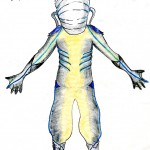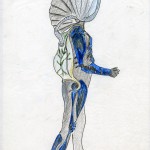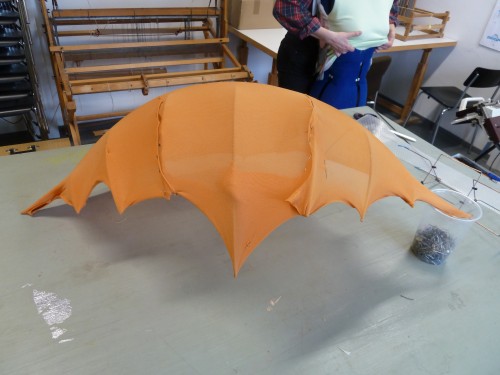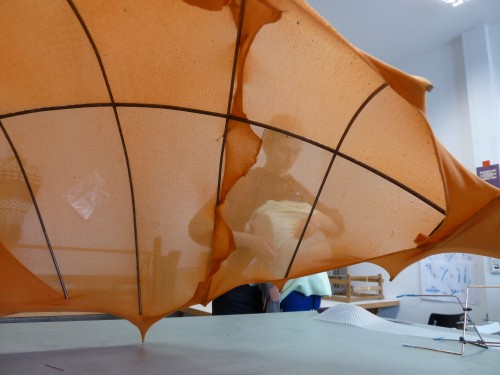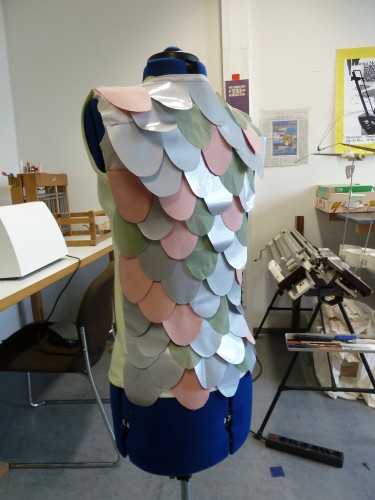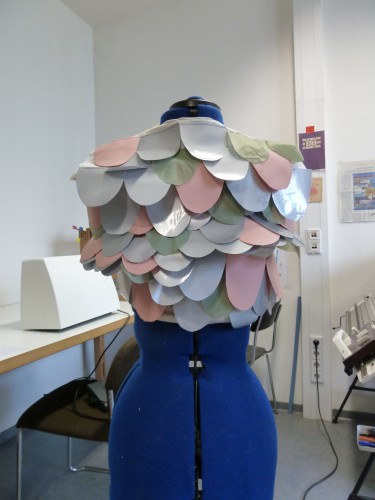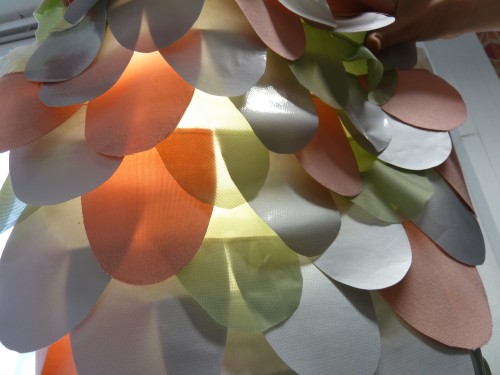Twenty Thousand Leagues Under the Sea (French: Vingt mille lieues sous les mers) is a classic science fiction novel by French writer Jules Verne published in 1870. It tells the story of Captain Nemo and his submarine Nautilus, as seen from the perspective of Professor Pierre Aronnax after he, his servant Conseil, and Canadian harpoonist Ned Land wash up on their ship. On the Nautilus, the three embark on a journey which has them going all around the world. From Wikipedia, the free encyclopedia
We, the team HEMASU chose to pick out the Nautilus´CREW. The interacitve costume we will create this semester is suppose to be worn by one of Nemo´s comrades. We specifically aim to built a suit that is also suitable for diving in the deep sea.
To get a clear vision of the crew I picked out some quotes from the original text by Jules Verne. I´m sorry that they are all in german. – I wrote an english summary at the end.
Die Mannschaft
S.64 – Kleidung, Sprache, Nationalität
Die beiden Unbekannten, mit Mützen von Seeotterfell und in Seestiefeln von Robbenfell, trugen Kleider von einem besonderen Gewebe, die große Freiheit der Bewegungen gestatteten. Der größere von beiden, offenbar der Anführer der Leute an Bord, prüfte uns mit größter Achtsamkeit, ohne ein Wort zu reden. Darauf besprach er sich mit seinem Gefährten in einer Sprache, die mir nicht bekannt war. Es war ein volltönender, harmonischer, biegsamer Dialekt mit sehr verschiedenartiger Betonung.
S.67 – Nationalität, Urteil zum „Typ“ Mensch
Seien Sie so freundlich zu warten, um mir ein Urteil über den Kommandanten und die Mannschaft dieses Fahrzeugs zu bilden.« »Ich bin mit meinem Urteil fertig«, versetzte Ned Land. »Es sind Schurken …« »Gut! Und aus welchem Land?« »Aus dem Schurkenland!« »Wackerer Ned, dieses Land ist auf den Karten noch nicht genügend bestimmt, und ich gestehe, daß die Nationalität der beiden Unbekannten schwer zu ermitteln ist! Weder Engländer noch Franzosen, noch Deutsche, das ist alles, was man bis jetzt sagen kann. Doch möchte ich annehmen, daß die beiden einer südlichen Breite angehören, sie haben etwas Südliches in ihrem Wesen. Aber ob Spanier, Türken, Araber oder Inder, läßt sich aus ihrem physischen Typus noch nicht ermessen. Ihre Sprache ist völlig unverständlich.«
S.68 – „Typ“Mensch, Bildung
Unterdessen hatte der Steward – stumm, vielleicht auch taub – den Tisch gedeckt und drei Gedecke aufgesetzt. Gewiß hatten wir’s mit Leuten von Bildung zu tun, und hätte uns nicht das elektrische Licht umstrahlt, so hätte ich geglaubt, im Speisesaal des Hotels Adelphi zu Liverpool oder des Grand-Hotels zu Paris zu sein.
S.87 – Essen
Auf Nahrungsmittel von der Erde habe ich lange verzichtet, und befinde mich darum nicht übler. Meine kräftige Mannschaft genießt dieselbe Nahrung wie ich.«
S.120 – Anzahl, Roboter?
Ich habe nicht einmal die Mannschaft des Boots gesehen. Sollte sie vielleicht auch elektrisch sein?« »Sie können mir nicht sagen, wieviel Mann an Bord sind? 10? 20? 50? 100?« »Ich kann darauf keine Antwort geben, Meister Land.
S.140 – Körpergröße
Kapitän Nemo, einer seiner Gefährten – eine herkulische Gestalt von außerordentlicher Körperkraft – Conseil und ich zogen rasch die Kleidung an.
S.205 – Kommunikation
Und er drückte auf einen elektrischen Knopf, wodurch er an seine Mannschaft den Befehl gelangen ließ.
S.207 – Fleiß, Arbeit
So verging die Nacht, ohne daß die Mannschaft von ihrer gewöhnlichen Untätigkeit abließ. Sie kümmerte sich um die Anwesenheit dieser Kannibalen so wenig, als die Soldaten eines festen Platzes um die Ameisen, die über seine Bollwerke laufen.
S.214
Ich vermutete, die Mannschaft sei mit inneren Reparaturen beschäftigt, die durch die Heftigkeit der mechanischen Bewegungen der Maschine notwendig geworden
S.324
Ein Teil der Mannschaft mit Skaphandern gepanzert, war beschäftigt, halb verfaulte Fässer abzuräumen und Kisten zu leeren inmitten des schwarzen Strandgutes.
S.364 – Anzahl
»Wieviel Mann glauben Sie, daß sich an Bord der ›Nautilus‹ befinden?« »Ich wüßte es nicht zu sagen, mein Freund.« »Es scheint mir«, versetzte Ned Land, »sein Manövrieren erfordert keine große Mannschaft.«
S.448 – Beziehung
Kapitän Nemo, in Blut gebadet, unbeweglich neben dem Fanal, sah ins Meer hinaus, das einen seiner Gefährten verschlungen hatte, und dicke Tränen quollen aus seinen Augen. Ich hatte also einen Heimatgenossen unter der Kapitän Nemo mit Leib und Seele verbundenen Mannschaft! War er der einzige Repräsentant Frankreichs in der aus verschiedenen Nationalitäten gemischten Gesellschaft? Ein ungelöstes Rätsel, das mich unablässig quälte. –> Nemo liebt seine Mannschaft. Wie Familienmitglied?
Kleidung
S. 128
Ich zog alsbald meine Byssuskleider an. Über die Beschaffenheit dieses Stoffs machte Conseil öfters seine Bemerkungen. Ich belehrte ihn nun, daß er aus den glänzenden seidenartigen Fasern gemacht sei, womit eine Art an den Ufern des Mittelmeers sehr häufiger Muscheln an die Felsen geheftet ist. Früher bereitete man daraus schöne Zeuge, Strümpfe, Handschuhe, denn sie waren zugleich kernhaft und sehr warm. Die Mannschaft der ›Nautilus‹ ließ sich darin billig kleiden, und man konnte die Baumwolle, Schafe und Seidenwürmer der Oberwelt entbehren.
S.320
Ich ging wieder in mein Zimmer und kleidete mich rasch an: Seestiefel, Ottermütze, Reiserock von Byssus mit Robbenfell gefüttert.
Was ist Byssus?
http://de.wikipedia.org/wiki/Byssus
Der Taucheranzug
S.139 f
_ schwer, undurchdringlichen, aus Kautschuk gefertigt
_ halten Druck aus
_ eine Rüstung, geschmeidig und widerstandsfähig zugleich
_ Hosen und Weste, durch Kupferplättchen geschützt, die der Brust zum Panzer dienten, um den Druck des Wassers auszuhalten und den Lungen ihre freie Tätigkeit zu sichern
_ dichten Fußbekleidung, mit schweren Bleisohlen besetzt
_ geschmeidigen Handschuhen, welche die Handbewegung nicht hinderten
_ Kleidung endigt oben in ein kupfernes, schraubenartig ausgebohrtes Halsband, worauf der metallene Helm eingeschraubt wird. Drei mit dicken Gläsern versehene Löcher gestatteten nach allen Richtungen zu sehen.
_ auf Rücken befestigten Apparate Rouquayrol fangen ihre Tätigkeit an, für das Atmen
_ Ruhmkorffsche Lampe am Gürtel
Summary – Crew
There are almost no specific, defined descriptions of Nemo´s crew. But it is possible to read a lot of information in the view mentioned parts. The crew must consist of a minimum of 12 members, all men, all from several different countries. They seem to all have a “southern” touch, but it is not clear from exactly where since the language they use to communicate with one another is unknown to scientist Aronnax. They execute any task that needs to be done on the Nautilus: Repair work, cloth making, cooking, hunting, collecting items from the sea, etc.
Nemo wears the cloth made of the same type of material that the crew wears. Also do they all eat the same food they derive from the sea. It must be healthy protein rich food since Nemo describes his crew to be strong. Especially one of his comrades looks like Herkules and is equally strong.
Sure is that the crew respect Captain Nemo completely. They come when called, they execute any task given to them. Maybe they even love Nemo. He certainly is bound to them with his heart and soul. When one of his comrades dies in an attac, Nemo starts crying in blank despair.
as for their clothing:
It´s made by elements from the sea. Caps made from sea otter, boots made for water from sealskin, and clothes made from fabric that allows good movements. This fabric he is talking about is called Byssus, made from mussels. It´s similar to silk. The crew makes clothes such as gloves or a coat insulated with sealfur with this type of textile.
Certainly we have to take into consideration that all the clothes are made from textiles/ materials found in the sea. But nonetheless we decided to have the play take place in a distant future, even in fictional world. So we do not have to take Jules Verne´s descriptions literally.

